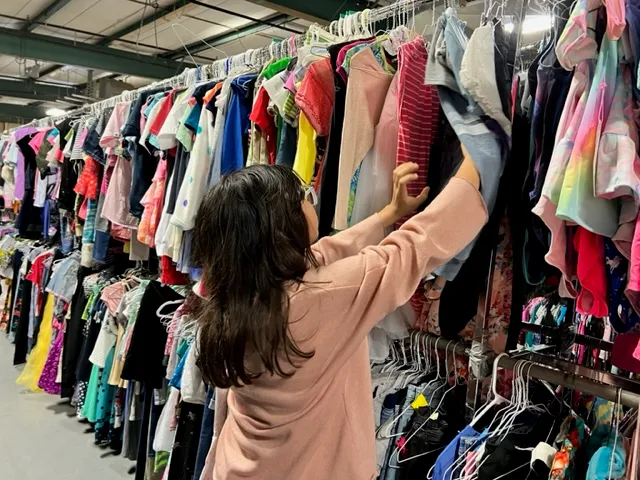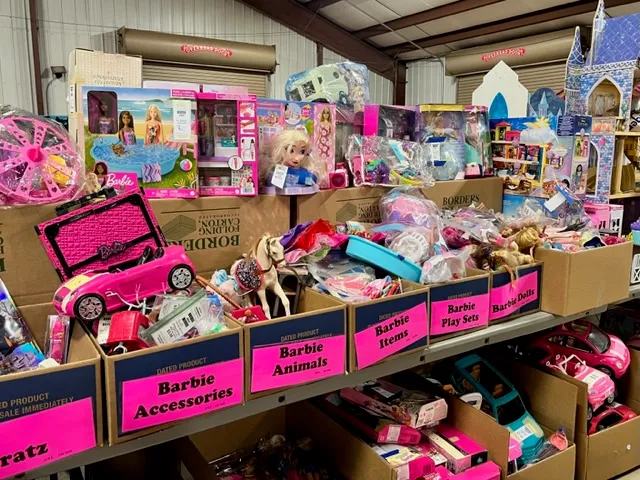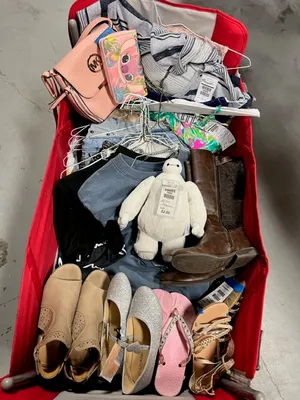Thinking of consignment selling? Here's how to maximize your time and money.

Jeri Lynn Cunningham held her first consignment sale out of her garage in 1994, when her son was 2 years old.
“I like nice things, but I didn't have the pocketbook to pay for the prices of those nice things,” the Georgia mom recalled. “So I started Kidsignments to be able to have what I didn’t have here: family to pass me down clothes.”
The biannual consignment sale has since become one of the largest in the country with 1,500 sellers packing two Gwinnett County fairground buildings with everything from gently used strollers to sports equipment.
“I still find stuff here,” said Cunningham’s son Branden Orta, who’s now 31. “I mean it’s the size of a super Walmart.”
Many families shop seasonal consignment sales like this to save money, but selling is another beast. Sorting, laundering, hanging, pricing and tagging every item can feel onerous to parents and guardians who are already short on time and energy.
Here’s what to know before deciding if consignment selling is actually worth it.
Our family spent a month cash stuffing:Here's our bumpy path to $1,000 in savings
How does consignment work?
There are a few ways to consign: through online marketplaces like Poshmark and Mercari, at brick and mortar consignment shops that stay open all year, and at in-person consignment sales that only pop up a few times a year in temporary spaces.
“(They were) pop ups before they were called pop ups,” Cunningham laughed. “We were doing resale before eBay existed.”
Sellers generally set prices for their own items and are paid a percentage of what actually sells.
Items that don’t sell are returned to sellers or in the case of online marketplaces, simply stay with them.

Is consignment a good idea?
Consignment selling can help parents and guardians earn back a sliver of what they spend on their kids, which the nonprofit and nonpartisan Brookings Institute estimates to exceed $310,000 before age 18. Any money earned can be funneled into future expenses as their children grow.
Selling unwanted items can also help the environment, by keeping them out the trash. The average person produces nearly 5 pounds of waste each day, according to the Environmental Protection Agency.
“Our motto is recycle, reuse and save,” Orta said. His mom was big on sustainable fashion long before it became trendy.
“It just made sense to help recycle kids’ clothes and toys and baby equipment and extend the life of those items,” Cunningham said.

How do you get started?
Preparing for a consignment sale can be daunting.
“Don’t get overwhelmed,” Cunningham encouraged. “What I do is I sort my items by price before I tag, and that way if I run out of time, I have used my time more effectively because I started pricing my most expensive items first.”
“Some of my sellers who are super organized, who've been selling multiple times, what they do is as soon as their child has outgrown an item, they immediately hang it on a hanger and they put it aside,” she added. “It makes it much easier when you go to prepare your items.”

How do you price items on consignment?
“Price your items to sell,” Cunningham advised.
She suggests pricing items at 25% to 30% of what they would cost new, or even less.
“If I paid $10, $3 would probably be a good price,” the Kidsignments’ founder said. “Let me mark it $2 because I really don't want it back. I always price $1 under what I would pay for the item just to help it move.”
Don’t let sentimentality inflate prices.
“There are certain outfits that are emotionally attached,” Cunningham said, still remembering how hard it was for her to let go of her son’s crib years ago. “After our sellers have been consigning for an event or two, that emotional aspect goes out the window.”
“You can resell it, make a little money and just pass on the good time you've had” with the items, Orta said. “Pass on the good memories.”

How do I get the most out of consignment?
“Make your stuff stand out above everybody else's,” Cunningham said. “Nobody likes to iron right? But if you press your little girl’s dresses, they really stand out versus one that might be right next to it that's a little bit wrinkled.”
She encourages accessorizing when possible.
“If you're selling that same little girl's dress, put a matching hair bow or headband with it or some matching cute little socks, and you can mark it up a bit more, get a little bit more for it,” she said. “The same dress might also be out there two or three times from different sellers, but yours is accessorized and pressed and looks nicer. It’s going to sell first.”
Do I have to pay taxes on reselling items?

Buyers pay sales taxes when they shop at consignment sales, but sellers usually don’t need to pay income taxes.
According to IRS Publication 525 , “If you sold an item you owned for personal use, such as a car, refrigerator, furniture, stereo, jewelry, or silverware, your gain is taxable as a capital gain.”
They key word there is 'gain.'
"When determining if a sale must be reported as income it isn’t the dollar amount that matters or how it was sold, but whether the item was sold for more than it was originally purchased," H&R Block contributor Teresa L. Clark explains in its Tax Information Center. "This is because selling something for more than you bought it results in a capital gain, which must be reported to the IRS as income."
In most cases, consignment sellers are actually taking a loss by selling items for less than what they paid for them, so there is no gain to report.
What if something doesn’t sell?
There are several reasons why an item may not sell.
It could be slightly overpriced. Cunningham suggested, “Next time, reduce it maybe $1 or even 50 cents.”
There could also be a lot of competition in a particular size.
Or it could be tough luck. “It just meant the right person didn't come through looking for that particular outfit,” Cunningham said, encouraging sellers to give themselves grace.
Sellers can try selling unsold items again at another sale or give them away to friends, family, neighbors or charity.
Just don’t throw them away.

Disclaimer: The copyright of this article belongs to the original author. Reposting this article is solely for the purpose of information dissemination and does not constitute any investment advice. If there is any infringement, please contact us immediately. We will make corrections or deletions as necessary. Thank you.






